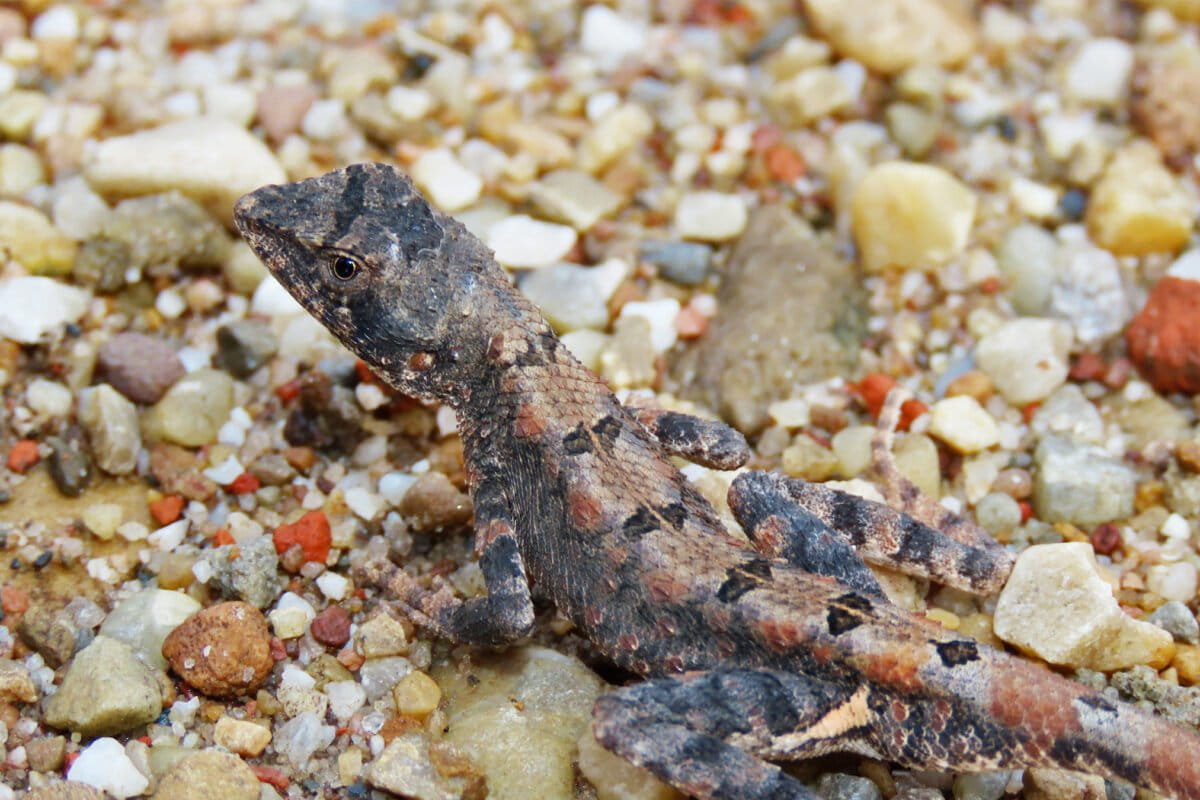- The dark sitana, a lizard endemic to a town in Nepal, is critically endangered by the loss and degradation of its habitat due to the BP Highway and unplanned urban development.
- Researchers are studying the ecology and threats of the dark sitana and conducting conservation outreach to raise awareness and support for its protection among local communities and stakeholders.
- The dark sitana is understudied and neglected by the government and needs more research and conservation efforts to prevent its extinction, researchers say.
KATHMANDU — On a hot and humid day in Bardibas, a town in the lowlands of Nepal, the sun beats down on the dusty roads where vans, cars and motorcycles zoom by, leaving behind a trail of black smoke. People traveling to the plains from the capital Kathmandu stop by to grab lunch as the smell of fish, spices and petrol exhaust fill the air.
In the last remaining green patches of this once-sleepy town, which sprang to life after the Japanese contractors handed over the highway to the government of Nepal in July 2015, a small creature hides itself from all the hullabaloo, trying not to get trampled. The critically endangered dark sitana (Sitana fusca), a rare lizard that hasn’t been reported anywhere else in the world, faces a host of challenges for its survival, most of them triggered by the highway development.
“The main threat to its existence is the loss of its habitat, which has been fragmented and degraded by the construction of the BP Highway,” says researcher Santosh Bhattarai, who is pursuing a Ph.D. in herpetology.
The highway, which took more than two decades to complete, is the shortest route connecting Kathmandu to the country’s eastern Terai. “It has triggered unplanned urban development, which has reduced natural vegetation and habitats of sitanas,” he added.

The brownish-gray lizard, which has black spots and stripes and a long tail that can be raised like a flag, is one of the most critically endangered reptiles in the world, according to the Red List of Threatened Species prepared by IUCN, the global conservation authority. During the mating season, males can protrude their fan-shaped throat. It is one of the three sitana species — the other two being Shuklaphanta sitana (S. schleichi) and Sivalik sitana (S. sivalensis) — reported in Nepal.
The species is so understudied that scientists are yet to understand which time of year it lays eggs and what its feeding habits are. Researchers are yet to come up with an estimate of its population.
To fill this knowledge gap, Bhattarai and his team have been studying the lizard for the past two years under a collaboration between the Nepal Conservation and Research Center and the Mithila Wildlife Trust. The project aims to collect ecological data on the dark sitana, such as its distribution, abundance, habitat characteristics and key threats, and develop a conservation strategy and identify conservation-sensitive zones where the dark sitana can be safeguarded
They have found that the dark sitana prefers open grasslands with patches of shrubs and trees, where it can bask in the sun and hide from predators.
In Nepal, people want to live close to the highway, as it gives them more economic opportunities. This has led to a building spree in areas that were once agriculture fields. It was a specimen from the agricultural fields that was described as a new species by Hans Hermann Schleich and Werner Kästle in 1998. But the fields are now being replaced with concrete jungles.
“Last time I went there, I had noticed a good habitat area for dark sitana in Bardibas. But when I went there recently, a house had been built,” Bhattarai added.

Researcher Bishal Prasad Neupane, a member of Bhattarai’s team, said they discovered more threats to lizards during interactions and outreach with the communities. “We found that the lizards in general are attracted to insects that feed on flowers,” he told Mongabay.
“When the lizards go after the insects, farmers believe that the lizards are eating the flowers and they kill them,” he added. Neupane said that frequent forest fires in the area where they are found is also a major issue.
Veteran herpetologist Karan Bahadur Shah said there is a general myth that lizards are poisonous. He added that in Nepal, species such as tigers and rhinos get most of the conservation attention, and research on herpetofauna has been limited.
Also, overall, the government hasn’t prioritized conservationist efforts in the eastern Terai, where unregulated mining for sand and gravel has impacted the habitat of a host of species, including stitanas, said Bhattarai.
Despite the challenges, Bhattarai and Neupane say they believe their work will lay the foundation for future research and conservation of the species. They say that by generating new information, developing conservation measures and engaging local people, they can play a role in saving this lizard from extinction.
“We also hope that other researchers also study the species, and the government also pays attention, as this lizard has only been found in Nepal. Its extinction wouldn’t send a positive message to the world,” Bhattarai added.
An elusive lizard thought to live only in India makes an appearance in Nepal
Feedback: Use this form to send a message to the author of this post. If you want to post a public comment, you can do that at the bottom of the page.
